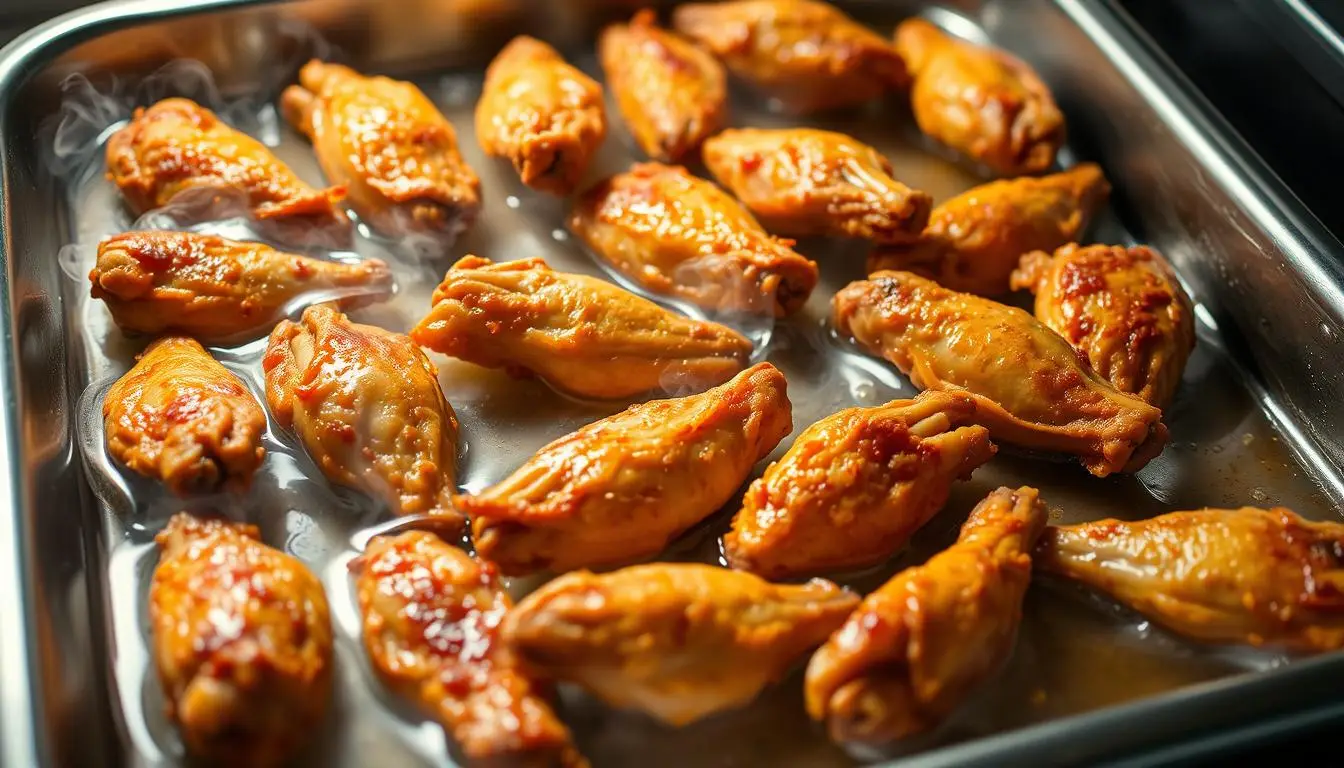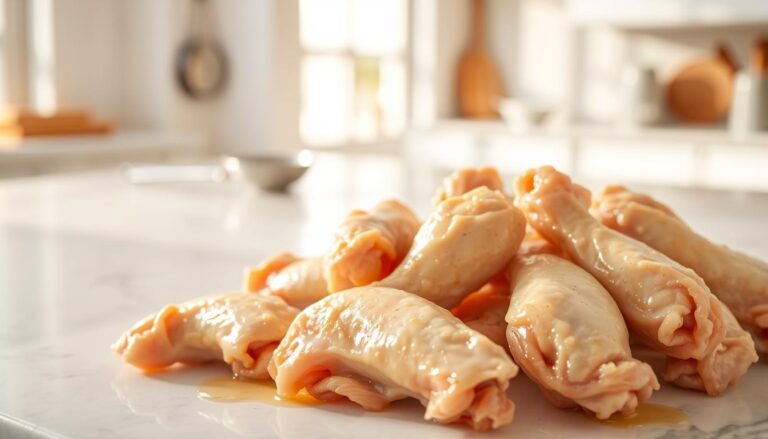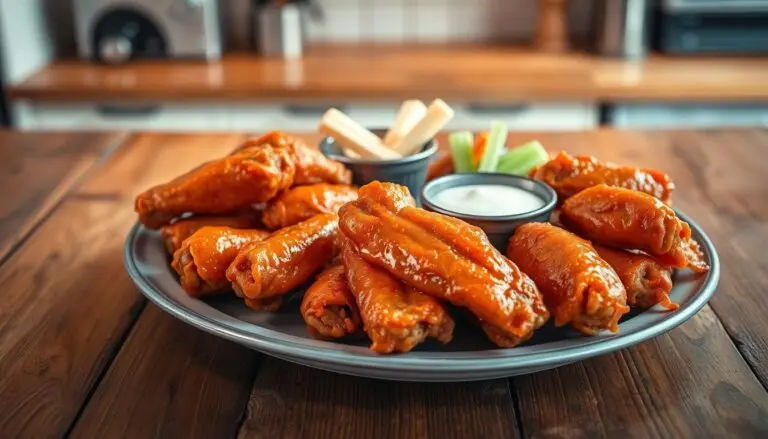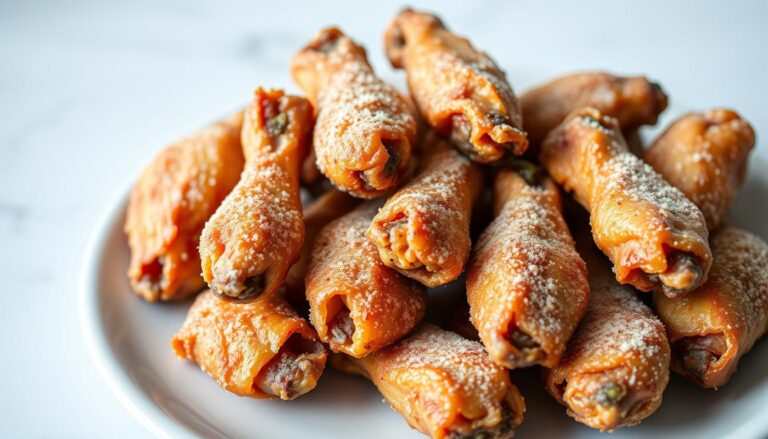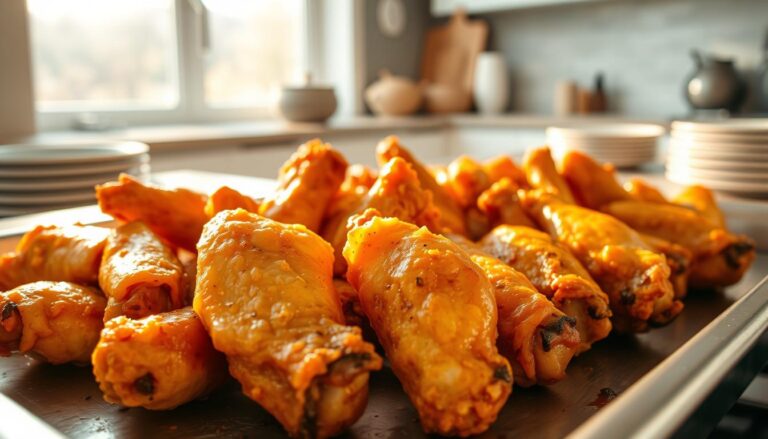Cooking Frozen Wings: Best Tips for Crispy and Juicy Results
Table of Contents
Ever looked into your freezer and wondered how to make frozen chicken wings delicious? Cooking frozen wings can make your meals quick and tasty. They’re perfect for satisfying your craving for crispy, juicy food.
Cooking frozen wings is more than just tossing them in the oven. It’s an art that needs careful temperature control and smart cooking methods. Plus, a few secret tricks can make your wings taste like they came from a restaurant.
Whether it’s game day or a quick dinner, learning to cook frozen wings will boost your cooking skills. With the right technique, you can make those frozen wings crispy and tender. Everyone will want to know your secret.
Ready to learn how to make wings that are perfectly cooked, crispy, and full of flavor? Your journey to making amazing wings starts now!
Understanding Frozen Wings: Types and Selection
Finding the right frozen chicken wings can be challenging. With the market growing at 5.2% CAGR from 2021 to 2028, knowing your options is key. This knowledge helps in making the perfect crispy frozen wings recipe.
Fresh vs. Frozen Wing Differences
Frozen chicken wings have many benefits for home cooks. They are convenient, last longer, and can taste as good as fresh wings if cooked right. These wings are flash-frozen to keep quality high and prevent freezer burn.
- Extended shelf life compared to fresh wings
- More affordable pricing
- Consistent quality and availability
- Easy to store and stock up
How to Choose Quality Frozen Wings
When picking frozen chicken wings, follow these tips:
- Look for minimal ice crystals, which show proper freezing
- Check the packaging for any damage
- Choose wings with fewer added preservatives
- Compare nutrition labels for protein content
Pre-cooked vs. Raw Frozen Wings
There are two main types of frozen wings:
| Pre-cooked Wings | Raw Frozen Wings |
|---|---|
| Faster preparation time | More control over seasoning |
| Less customization possible | Requires longer cooking time |
| Often pre-seasoned | Allows for personal flavor profiles |
Pro tip: Foster Farms and TGI Fridays are top brands for frozen wings. Foster Farms Hot & Spicy wings got a perfect 10/10 in taste tests.
Essential Equipment and Preparation Steps
To make an easy frozen wings recipe, you need the right tools and preparation. Choosing the right equipment and knowing how to prepare is key. This will help you make delicious frozen wings.
Must-Have Cooking Equipment
- Baking sheet with wire rack
- Digital meat thermometer
- Parchment paper
- Sharp kitchen scissors
- Air fryer or conventional oven
The quality of your equipment matters a lot. A wire rack is important. It lets hot air get to the wings, making the skin crispy.
Preparation Essentials
Before you start cooking, follow these important steps:
- Check the wing packaging for thawing instructions
- Pat the wings dry with paper towels
- Season the wings with your favorite dry rub or salt
- Let the wings sit at room temperature for 15-20 minutes
| Equipment | Purpose | Recommended Type |
|---|---|---|
| Meat Thermometer | Ensure Safe Internal Temperature | Digital Instant-Read |
| Baking Sheet | Even Heat Distribution | Heavy-Duty Aluminum |
| Cooking Spray | Prevent Sticking | Olive Oil Based |
Your aim is to make crispy, juicy wings with little effort. The right tools and preparation are essential. They help turn frozen wings into a tasty meal that everyone will love.
Cooking Frozen Wings: Methods and Temperatures
Preparing delicious frozen wings requires understanding different cooking techniques. Whether you’re cooking frozen wings in the oven or using an air fryer frozen wings recipe, the right method can transform your meal from ordinary to extraordinary.
To achieve perfect wings, you’ll want to explore multiple cooking strategies that ensure crispy exterior and juicy interior. Professional chefs recommend two primary methods: oven-baking and air frying.
Oven-Baking Method at 425°F
Cooking frozen wings in the oven is straightforward and reliable. Follow these steps for optimal results:
- Preheat oven to 425°F
- Line baking sheet with parchment paper
- Arrange wings in single layer
- Bake for 50-60 minutes
- Flip wings halfway through cooking
- Ensure internal temperature reaches 165°F
Air Fryer Technique at 400°F
An air fryer frozen wings recipe offers faster cooking with exceptional crispiness. Here’s a foolproof method:
- Set air fryer to 400°F
- Place wings in single layer
- First fry for 10 minutes to defrost
- Discard accumulated liquid
- Season wings
- Second fry for 12 minutes
- Check internal temperature reaches 165°F
Double-Cooking Strategy for Extra Crispiness
For ultimate crispy wings, combine cooking methods. Start with slow baking or air frying to cook through, then finish under the broiler or with a high-heat blast to create a perfectly crisp exterior.
Pro tip: Always cook wings in a single layer to guarantee even cooking and maximum crispiness. Experiment with different seasonings to discover your perfect wing recipe!
Time Management and Temperature Control
Mastering the art of cooking frozen chicken wings requires careful attention to time and temperature. Knowing the critical temperature zones is essential for safe and tasty wings. The danger zone for food safety is between 40°F and 140°F. This makes controlling the temperature vital to stop bacteria from growing.
Here are the key time and temperature tips for cooking frozen wings:
- Thaw wings safely in the refrigerator within 1-2 days
- Use cold water thawing for faster preparation (about 1 hour per pound)
- Avoid microwave thawing when possible
When cooking frozen wings, it’s important to monitor the temperature closely. Make sure your chicken reaches an internal temperature of 165°F for food safety. A reliable meat thermometer is your best kitchen tool for these tasty treats.
Time management is key to cooking wings perfectly. Plan for:
- 30 minutes of preparation
- 45-60 minutes of cooking
- 15-20 minutes of resting and finishing
Pro tip for frozen chicken wings cooking: Never refreeze chicken thawed in cold water or microwave. Always cook immediately to keep food safe and the texture right.
Temperature control isn’t just about cooking—it’s about creating restaurant-quality wings in your own kitchen.
For long-term storage, keep frozen wings at 0°F or below. Use them within two months for the best taste and quality.
Seasoning Strategies for Maximum Flavor
To turn delicious frozen wings into a tasty meal, you need the right seasoning. The way you cook your spicy frozen wings can make simple ingredients taste amazing. It all comes down to how you add flavor.
Knowing when and how to use seasonings is key. It can change how your wings taste. Different methods work better for different flavors.
Dry Rub Applications
Dry rubs are a great way to add deep flavor to your wings. Here are some tips:
- Put dry rub before cooking for the best taste
- Use spices like paprika, garlic powder, and cayenne
- Make sure wings are dry before rubbing
Marinade Timing and Techniques
Marinating frozen wings needs careful planning. You can’t marinate frozen meat directly. But, you can thaw wings a bit and then marinate them.
| Marinade Type | Recommended Marination Time | Flavor Profile |
|---|---|---|
| Citrus-Based | 30-60 minutes | Bright, Tangy |
| Spicy Chili | 1-2 hours | Intense Heat |
| Herb-Infused | 2-4 hours | Aromatic |
When to Add Sauces
Adding sauces to your wings is all about timing. Add them in the last 5-10 minutes to avoid burning. For extra crispiness, toss wings in sauce after they’re done.
Pro tip: Let wings rest for 5 minutes after cooking before adding sauce to help it adhere better.
Achieving the Perfect Crispy Texture
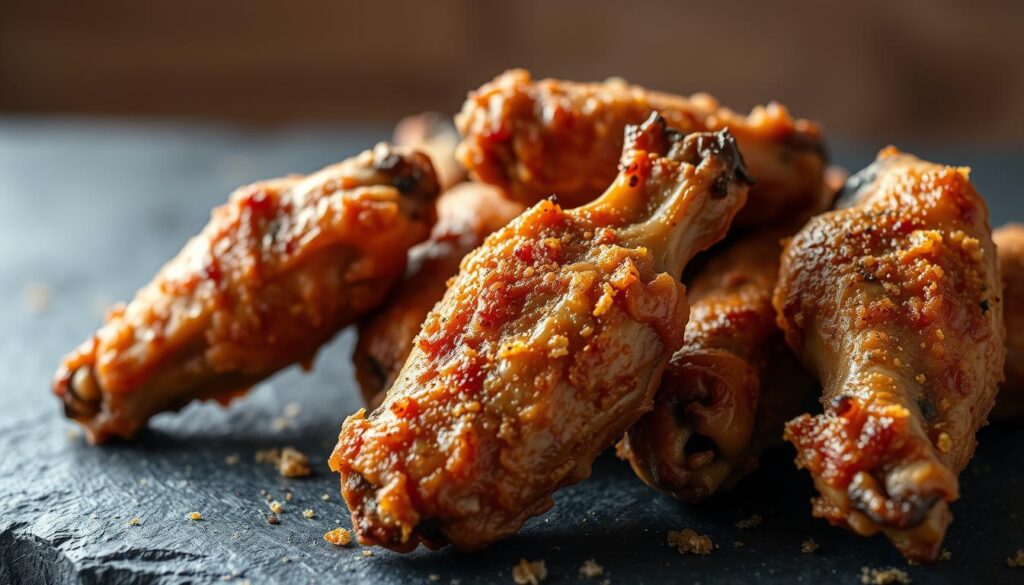
To get crispy frozen wings, you need the right cooking techniques. Start by learning how to change their texture from soggy to crispy. You want wings that are golden and crunchy on the outside, but juicy inside.
Here are some tips to make your wings extra crispy:
- Pat wings dry with paper towels before cooking
- Lightly dust wings with cornstarch or baking powder
- Cook at high temperatures between 400-425°F
- Use a two-phase cooking strategy
Removing excess moisture is key to crispy wings. Moisture is the enemy of crispiness. Patting wings dry prepares them for crispiness. Cornstarch or baking powder absorbs extra moisture and helps them brown.
Temperature is important when cooking frozen wings. High heat triggers the Maillard reaction, making them golden-brown. Cooking in a single layer ensures even heat and prevents steaming, which can make wings soggy.
Pro tip: If using an air fryer, flip your wings halfway through cooking. This ensures even browning and gives you that crispy texture everyone loves.
Sauce Combinations and Coating Methods
Turning your frozen wings into a feast is more than just cooking. The right sauce and coating make them unforgettable. It’s like turning a simple meal into a journey of flavors.
When you explore spicy frozen wings, you learn about sauce and flavor balance. Each sauce brings a new taste, making your wings exciting.
Classic Buffalo Style
Buffalo sauce is the top choice for wings. To make authentic buffalo sauce:
- Mix hot sauce with melted butter
- Adjust heat by changing sauce-to-butter ratio
- Make sure wings are fully coated for the best taste
BBQ and Alternative Sauces
There are many other sauces to try:
- Honey Sriracha: Sweet and spicy
- Teriyaki for a taste of Asia
- Garlic parmesan for a creamy flavor
Professional Tossing Techniques
Coating wings right needs the right tossing method. Use a big metal bowl and gentle circular motions. This ensures even sauce and keeps the wings crispy.
Pro tip: Always toss wings right after cooking while they’re hot. This helps them soak up the sauce better.
With these tips, you’ll make wings that wow anyone.
Serving Suggestions and Pairings

When you make an easy frozen wings recipe, how you serve them matters a lot. Experts say to plan for about 10 wings per person if they’re the main dish. If they’re just appetizers, aim for 7 wings per person.
Here are some fun ways to serve your delicious frozen wings:
- Classic Side Dishes:
- Crispy French fries
- Celery sticks with blue cheese dressing
- Onion rings
- Vegetable Pairings:
- Sweet coleslaw
- Roasted sweet potatoes
- Mexican street corn
Drinks can also enhance your wing experience. Pro tip: Try serving sweet tea, lemonade, or ice-cold beer.
To make a full meal, pair your wings with a carb-heavy side and a veggie side. Sauces like ranch, blue cheese, and BBQ can add a lot of flavor to your wings.
Pro Chef Recommendation: Mix and match side dishes to create a memorable dining experience!
Storage and Reheating Guidelines
Keeping your frozen chicken wings fresh is key. Knowing how to store and reheat them can greatly improve taste and safety.
After cooking, store chicken wings in the fridge for up to 4 days. It’s important to refrigerate them within two hours of cooking. Use airtight containers or wrap them in foil to keep moisture and flavor in.
Refrigeration Guidelines
- Store wings at or below 41°F (5°C)
- Use sealed containers to prevent bacterial growth
- Consume within 3-4 days for optimal freshness
Freezing Strategies
- Freeze cooked wings for up to 4 months
- Maintain freezer temperature at 0°F (-18°C)
- Wrap wings tightly to prevent freezer burn
When reheating wings, make sure they reach 165°F (74°C). You can reheat them in several ways:
- Oven: Reheat at 350°F for 15-20 minutes
- Microwave: Heat on high for 2-3 minutes
- Stovetop: Warm at medium heat for 5-7 minutes
“Always prioritize food safety when storing and reheating chicken wings” – USDA Food Safety Guidelines
Look out for signs of spoilage like bad smells, slimy texture, or color changes. If unsure, throw them away to keep yourself safe.
Troubleshooting Common Issues
When making a crispy frozen wings recipe, you might face some challenges. These can affect the dish’s quality. Cooking frozen wings needs careful attention and knowing common problems.
Excess moisture is a big issue for many cooks. Frozen wings can release a lot of water, making it hard to get a crispy outside. To fix this, dry the wings with paper towels before seasoning.
Put the wings on a wire rack to help air circulate. This method gets rid of extra liquid. It ensures your wings turn out crispy and flavorful.
Dealing with Excess Moisture
Uneven cooking is another problem. Different wing sizes and parts cook at different rates. This can make some parts undercooked and others dry.
Preheat your cooking surface well and space the wings evenly. This helps them cook evenly. Use a meat thermometer to check if they’re cooked to 165°F. This ensures they’re safe to eat.
Preventing Uneven Cooking
Texture issues can ruin your crispy frozen wings. If they’re soggy or rubbery, try changing the cooking temperature. You can also try air frying or double-cooking.
Increasing the oven temperature or using convection settings can help. This method gets the outside crispy while keeping the inside juicy.
Must-Have Tools for Effortless Cooking
For the best cooking experience, these essential tools will make your time in the kitchen easier and more efficient:
✅ Baking Sheet with Wire Rack – Perfect for roasting, baking, and air frying with better heat circulation.
✅ Digital Meat Thermometer – Ensure your meats are cooked to the perfect temperature every time.
✅ Parchment Paper – A non-stick lifesaver for baking, roasting, and easy cleanup.
✅ Sharp Kitchen Scissors – Great for cutting herbs, trimming meat, and opening packaging effortlessly.
✅ Air Fryer or Conventional Oven – Whether you prefer air frying or traditional baking, the right appliance makes all the difference.
For more Chicken Wings Recipes Check Our Related Posts

